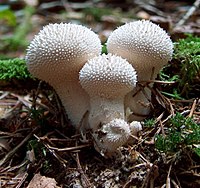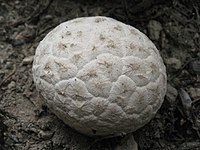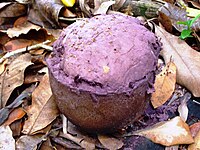
Back فطر نفاث Arabic پەفتۆپ CKB Bovist German Hongos polvera Spanish قارچ پفی Persian Vesse-de-loup French Bolgán béice Irish Peido de lobo Galician Telok-pipit ID Poufascht LB
Puffballs are a type of fungus featuring a ball-shaped fruit body that (when mature) bursts on contact or impact, releasing a cloud of dust-like spores into the surrounding area. Puffballs belong to the division Basidiomycota and encompass several genera, including Calvatia, Calbovista and Lycoperdon.[1] The puffballs were previously treated as a taxonomic group called the Gasteromycetes or Gasteromycetidae, but they are now known to be a polyphyletic assemblage.
The distinguishing feature of all puffballs is that they do not have an open cap with spore-bearing gills. Instead, spores are produced internally, in a spheroidal fruit body called a gasterothecium (gasteroid 'stomach-like' basidiocarp). As the spores mature, they form a mass called a gleba in the centre of the fruitbody that is often of a distinctive color and texture. The basidiocarp remains closed until after the spores have been released from the basidia. Eventually, it develops an aperture, or dries, becomes brittle, and splits, and the spores escape. The spores of puffballs are statismospores rather than ballistospores, meaning they are not forcibly extruded from the basidium. Puffballs and similar forms are thought to have evolved convergently (that is, in numerous independent events) from Hymenomycetes by gasteromycetation, through secotioid stages. Thus, 'Gasteromycetes' and 'Gasteromycetidae' are now considered to be descriptive, morphological terms (more properly gasteroid or gasteromycetes, to avoid taxonomic implications) but not valid cladistic terms.
True puffballs do not have a visible stalk or stem, while stalked puffballs do have a stalk that supports the gleba. None of the stalked puffballs are edible as they are tough and woody mushrooms.[2] The Hymenogastrales and Enteridium lycoperdon, a slime mold, are the false puffballs. A gleba which is powdery on maturity is a feature of true puffballs, stalked puffballs and earthstars. False puffballs are hard like rock or brittle. All false puffballs are inedible, as they are tough and bitter to taste. The genus Scleroderma, which has a young purple gleba, should also be avoided.[2]
Puffballs were traditionally used in Tibet for making ink by burning them, grinding the ash, then putting them in water and adding glue liquid and "a nye shing ma decoction", which, when pressed for a long time, made a black dark substance that was used as ink.[3] Rural Americans burned the common puffball with some kind of bee smoker to anesthetize honey bees as a means to safely procure honey; the practice later inspired experimental medicinal application of the puffball smoke as a surgical general anesthetic in 1853.[4]
- ^ Freedman, Louise; Mycological Society of San Francisco (2000) [1987]. "Wild About Mushrooms:Puffballs". Archived from the original on 2008-09-28. Retrieved 2008-08-03.
- ^ a b Miller, Orson K. (1977). Mushrooms of North America. New York, NY: E.P. Dutton Publisher. p. 298. ISBN 978-0-525-47482-1.
- ^ Cuppers, Christoph (1989). "On the Manufacture of Ink." Ancient Nepal – Journal of the Department of Archaeology, Number 113, August–September 1989, p. 5.
- ^ Hopper, Christopher P.; Zambrana, Paige N.; Goebel, Ulrich; Wollborn, Jakob (2021-06-01). "A brief history of carbon monoxide and its therapeutic origins". Nitric Oxide. 111–112: 45–63. doi:10.1016/j.niox.2021.04.001. ISSN 1089-8603. PMID 33838343. S2CID 233205099. Archived from the original on 2021-04-27. Retrieved 2021-04-26.


